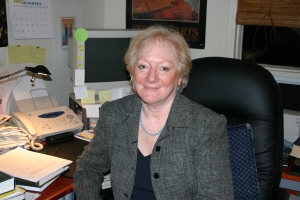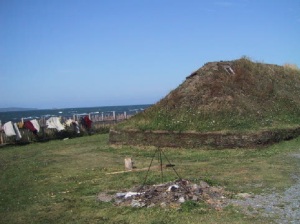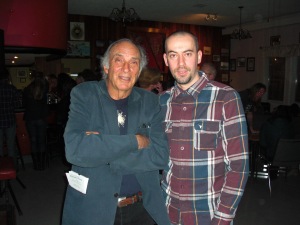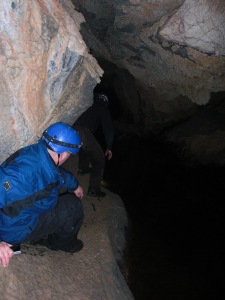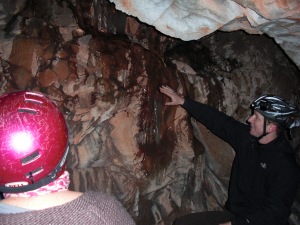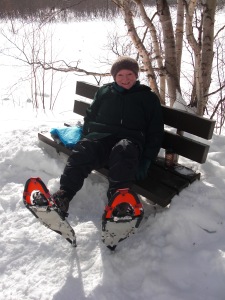Well last week’s quiz provoked the most response so far, with only a few claiming to have gotten 15 or more right. Anyway, today’s quiz gets you an honorary Corner Brooker seal (oops, touchy word here) if you get 15 or more right. Answers at the end.

Corner Brook city hall.
1. There’s a brand new city hall. A local commentator in the newspaper has been quoted as saying that the outdoor clock “must have been designed by a mainlander”. Why?
a) it was never accurate
b) it couldn’t be easily seen by either drivers or pedestrians where it was placed
c) it gave mainland time, not Newfoundland Standard Time, which is a half-hour different
d) it was digital
2. Maybe cruise ships will dock at Corner Brook this fall. Which statement is true:
a) don’t be silly, fool, why would cruise ships come to Corner Brook?
b) don’t be silly, fool, cruise ships require a deep harbour and there’s not one in all of Newfoundland
c) don’t be silly, fool, of course they’ll come, 15 are booked already
d) don’t be silly, fool, cruise ships come to Newfoundland, but they only stop in colourful St. John’s

Shez (?) West restaurant, Corner Brook
3. Can a town with a restaurant called Shez West (that’s Shez, not Chez) offer fine dining? Which of these statements is not true of Corner Brook:
a) there is a barista at Brewed Awakening on West St.
b) there is fine Indian dining at Indian on the West
c) sushi is available at Newfound Sushi as well as fresh at Coleman’s grocery store
d) Gitanos’ Supper Club and Tapas Bar offers casual elegance (and live music Fridays)
e) Sorrento offers excellent Italian food, but you will likely need a reservation
f) The Mamateek Inn offers the best dining view in town, but not fine dining
4. You want to place a classified ad in The Western Star, the local paper. The large building is located right across from your closest Tim Hortons, so you pop in and say you want to run an ad. What happens? (Worse than that, why are all these unbelievable answers so likely?)
a) you’re told that you can’t place it in person, you have to phone and you can’t use their phones
b) the clerk phones someone who comes to take your ad, but you need to go elsewhere to pay, and they don’t take cash or debit, only Visa
c) the clerk phones Montreal and is put on hold for ten minutes
d) the clerk says no-one uses the classifieds any more except companies from Fort McMurray needing workers, because of all the free classified sites on the internet

Local glass artist Urve Manuel
5. Urve Manuel is a local glass artist. (Yes, we bought a piece.) She was commissioned to do a spectacular 22 foot installation at the Deer Lake Regional Airport. It was called:
a) “A Stone’s Throw”, representing how close Deer Lake is to Gros Morne National Park, only 15 minutes away
b) “Salmon Run” because the nearby Humber River is the world’s greatest salmon fishing river, with 70,000 going upriver every year
c) “Net Worth” showing colourful cod fish, a Newfoundland symbol, milling in a net
d) “Coming and Going” featuring different very large Newfoundland fish going in different directions, like travellers
6. There are interesting towns close by to Corner Brook. Which of these statements is false?
a) Deer Lake, 30 minutes away, was named by the early settlers from Cape Breton, who saw deer swimming across the lake
b) Pasadena, 15 minutes away, means beautiful valley, and it was named by a guy who met a girl in Pasadena, California, liked the name and the girl, and brought both back home
c) Stephenville, 30 minutes away, has its streets named after American states
d) Lark Harbour, 20 minutes away, was named after one of Captain James Cook’s boats
7. A long whistle sounded at 4 o’clock today that could be heard throughout the city. It was:
a) the Newfie Bullet, the train that travels across the province, signalling that it was ready to leave
b) a call to alert the volunteer firemen to call City Hall for the location of a fire
c) the ferry leaving for Blanc Sablon, Quebec, (at the Labrador border) signalling it was about to leave
d) the whistle from Corner Brook Pulp and Paper marking the end of a shift

Yes, Empire Theatres does have a marquee.
8. It’s February. You want to go to a movie in Corner Brook. There’s only one theatre. You find out what’s playing by:
a) driving by to look at the large marquee
b) looking for the ad in The Western Star
c) going to cornerbrooker.com to see the regular movie listings
d) all of the above
e) none of the above, you can’t find out what’s on until you go inside the mall
9. The CBC has a 9-week Live Right Now Challenge which offers a $100,000 nature park for the winning community. The idea is for communities to exercise more and eat healthier. Corner Brook is one of the final 13 communities in Canada! Which of the following is true:
a) as part of its social media section, the City of Corner Brook used this blog because it showed residents (i.e. Bill and Pauline) snowshoeing, dog sledding, caving, snowmobiling and generally exercising
b) there was a healthy dessert contest at the Pepsi Centre (no irony intended)
c) a massive Zumba class was led by the Humber Community YMCA
d) all of the above
e) two of the above

Grenfell's brand new observatory, soon to be fully operational.
10. Corner Brook’s Grenfell Campus of Memorial University has a new observatory waiting to be put into full operation, the largest in Maritime Canada. What’s the hold up?
a) the steel dome containing the telescope is frozen shut and covered with ice from the winter weather, so they’re waiting for warmer weather
b) a mainlander sent over the wrong lens, holding things up
c) the steel dome containing the telescope cannot be heated since the warm air rising from an opened dome would distort the images being observed, so they’re waiting for warmer weather
d) it’s not an observatory, it’s a planetarium, so it isn’t being held up by the wrong lens
11. Which of these does not exist in Corner Brook:
a) high speed internet
b) CBC’s The National
c) Rogers Cantel mobile phone service
d) Rogers digital t.v. and internet
e) Bell satellite service
12. In the last 4 years all of these have been built in Corner Brook except:
a) a new court house
b) a new city hall
c) a new skateboard park
d) a new long-term care health centre
e) a new curling rink
f) new buildings at Grenfell, along with an observatory
13. The City of Corner Brook has 19,886 people officially. I guess you don’t need 20,000 to be a city here. Anyway, an awful lot of stuff gets built (see #12). What serious financial cost is missing from Corner Brook’s budget?
a) firemen’s wages, it’s all volunteer
b) police wages, the Royal Newfoundland Constabulary are paid by someone else
c) salaries for the mayor and councillors, they all work pro bono
d) salaries for staff, there’s hardly any for what is basically just a small town

Is that garbage under there? Why the netting? (2008 photo)
14. Every Thursday in our section of town nets and blankets are strewn over lawns and driveways. They have been covering the green garbage bags. What is the garbage being protected from?
a) feral cats
b) rabbits or hares
c) coyotes
d) seagulls
e) crows or ravens
f) all of the above
g) two of the above
15. Which of the following was not a recent headline in The Western Star:
a) Polar bear shot after breaking into four homes, killing sheep, ducks in Goose Cove (possibly a world record for longest headline)
b) Feral cats a danger (may be infected by rabies)
c) Police issue caribou warning (the caribou change colour in winter, unlike the moose, so they blend in and are hard to see crossing roads)
d) Man shoots 82 lb. coyote (the government gives a $25 bounty per coyote)
16. Hey, this headline business is fun. Which headline is fake?
a) Moose in danger? (dealing with the significant expected decline in the moose population)
b) Humane Society to sealers: “Let’s Talk” (the talk is about buying out the sealers and so ending the annual seal harvest once and for all)
c) RCMP issue polar bear warning (this one was on land but left on some ice with a seal, but it could end up in Wesleyville, depending on the tides)
d) Wild rabbit meat banned for commercial purposes (rabbits or hares can’t be sold at events such as the United Church annual rabbit supper)
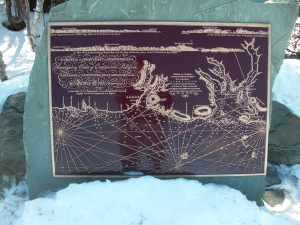
One of the many plaques at Captain Cook's monument overlooking Corner Brook and the Humber Arm and the Bay of Islands.
17. Captain James Cook helped defeat the French at Quebec. Then he helped liberate St. John’s from the French who had captured it in The Seven Year’s War to use as a bargaining chip. He then mapped Newfoundland and stayed in Corner Brook while mapping the area. As a reward for such excellent maps, used for almost 200 years, he was sent to:
a) Tahiti

View from Captain Cook's monument.
b) Vancouver
c) Australia
d) Hawaii
e) New Zealand
18. Tom Cochrane is a young local. He has gained fame for:
a) shooting a moose weighing 1832 lbs. on his first moose hunt
b) opening a sushi restaurant in a town where they said it wouldn’t go because people want trucker meals like a Jiggs Dinner
c) establishing his own band, following in the footsteps of his father, Tom Cochrane, who had a big hit with “Life is a Highway”
d) establishing a blog, cornerbrooker.com, in June, 2010, that won Best Overall Blog at the 2011 Canadian Blog Awards

Are there really sidewalks in this part of town?
19. It has snowed every week since January 1. At home, if you don’t shovel your sidewalk within 24 hours, you’re fined. Here Bill doesn’t shovel the sidewalk. Why not?
a) that’s Pauline’s job
b) the guy two doors down has a great snowblower (lights and everything) and is happy to clear all the neighbours’ sidewalks
c) there are no sidewalks in the part of town we live in, Townsite
d) there is so much snow, no-one clears their sidewalks, people just walk on the road
e) the people in this part of town are too old to shovel and if Bill clears his sidewalk, it looks bad

The Sir Richard Squires Building, an eyesore of a highrise in a majestic valley. Most residents like to see the trees on the horizon. With lots of land available, most of the new buildings have a low profile, suiting the environment.
20. Sir Richard Squires was Liberal Prime Minister of Newfoundland twice. His government was accused of using bribes to win the 1923 election. He was arrested, released on bond and so resigned. After being re-elected, his finance minister revealed Squires was receiving secret payments out of public funds. Over 10,000 people marched on the House of Assembly, broke in when no-one came out, and Squires, disguised, escaped out the back door. He brought Newfoundland close to bankruptcy and he was the one who offered to sell Labrador to Canada for $98 million. (Canada refused). He was also fined for income tax evasion. In Corner Brook, there is a high-rise named The Sir Richard Squires Building. Unbelievable! Why?
a) well, he was a local boy
b) this is a Liberal stronghold in a Conservative province, so there you go
c) he built the railway that connected the whole province
d) he brought a pulp and paper mill to Corner Brook
e) every-one knows that every old-time politician was corrupt in this province, so it doesn’t much
matter to people
21. Bonus question. Pauline stopped to watch a small boy at Canadian Tire who was fascinated by something. His mother confided; “He’s never seen one o’ those in Labrador.” What was it?
a) an escalator
b) people going through an entrance turnstile
c) an elevator
d) a mechanical claw that picks up plush toys
Answers. 1. b You can’t see the clock in the picture because it’s up by the flag at the top facing the street. 2. c Corner Brook has a fabulous deep-water harbour. The cruise ships come for the spectacular fall colours here and because Gros Morne is only an hour away. 3. b 4. c 5. d Urve’s business is called “A Stones Throw Glass Studio” and “Salmon Run” and “Net Worth” are titles of other major works she has done.
6. a There are no deer in Newfoundland! What they saw was caribou, but they thought they were deer. Stephenville was an American military base, so that’s what’s up with the street names. 7. d A beautiful sound we hear every week-day. It’s so nostalgic. 8. e Well, you could also look it up on the internet at Empiretheatres.com but I hate computers. In defense, maybe it was too cold in February and March. Now in April, ONE side of the marquee tells the movies. 9. d 10. c
11. c 12. c But they did buy new equipment for the old skateboard park, and they promise a new park soon! 13. b
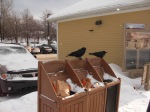
It must be Saturday.
14. g (both d and e) First the ravens rip open the bags, then the seagulls swoop in and it’s “one beejeesus mess”. On Saturdays, with no garbage collection, the ravens go to Timmies and I have the pictures to prove it! 15. b There are feral cats and some communities are trying to round them up, but so far they haven’t made it into the headlines
16. d 17. a 18. d 19. d If you picked “a”, you lose 2 points, unless you’re from Corner Brook where I see a lot of women shovelling driveways. 20. d Well, that’s the only real answer anyone has come up with so far, although my other entries may be partially right, too. 21. b Amazing what we take for granted, isn’t it.
















